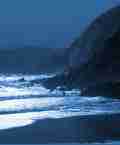 |
 | |||

There are several accounts of Columba's life, all attesting to the miraculous signs which preceded his birth at Gartan, Co. Donegal, in 521. An angel assured his mother that she would bear a son of great beauty who would be remembered among the Lord's prophets. Saint Buite, the dying abbot of Monasterboice in Co. Louth, is said to have foretold the birth of "a child illustrious before God and men". Columba was of royal blood. His father Phelim was of the Uí Néill clan and descended from the famous Niall of the Nine Hostages, while his mother Eithne was descended from a king of Leinster.
It was the custom for the children of ruling families to be fostered, but unusually Columba was put into the care of a priest. The boy's daily practice of reading the psalms led his young contemporaries to call him Columcille (Colum of the church) and he is more usually known by that name in Ireland. He went on to study under Saint Finnian of Moville, Co. Down, where his prayers are said to have turned spring water into communion wine. He later became a pupil of Saint Finnian of Clonard and was destined to become the most famous of the latter's "twelve apostles of Ireland". Columba also spent time with a Leinster bard named Gemman, in whose company he witnessed the murder of a young girl and vowed that as the girl's soul went to Heaven the murderer's soul would go to Hell. When the murderer immediately died, Columba's reputation spread rapidly.
Legend has it that Columba's exile was an act of penance, and that he deliberately chose an island out of sight of his beloved Ireland. During a visit to Moville, Columba is said to have secretly copied a book of psalms. When Finnian discovered this, he insisted on having the copy. Columba refused to hand it over, and their dispute was referred to the high king, Diarmuid, who ruled: "To every cow her calf, and to every book its copy". Columba already resented Diarmuid for slaying a youth to whom the saint had given sanctuary and he persuaded his kinsmen to wage war. Diarmuid was defeated at Cuildreimhne, Co. Sligo and Columba was blamed for the hundreds of dead. When a synod called on him to make amends by converting an equal number of pagans, he opted to work among the Picts of Scotland. The extent of Columba's missionary work has probably been exaggerated by his early biographers, but there is no doubting the profound influence of Iona on the Celtic Church as a whole, and on the spread of Christianity in Scotland and northern England. Columba was also a political figure of consequence. His early conversion of Brude, king of the Picts, reduced the threat of attacks on Christian Dalriada. In 575, returning to Ulster for a convention held at Drum Ceatt, he negotiated the Scottish kingdom's independence from the Irish Dalriada. At the same convention he persuaded King Aedh to preserve the bards of Ireland, whose satires had made them unpopular. Columba died on Iona in 597. Chronicles of his life appeared in the following century, most notably from Saint Adomnán, who attributed to him many prophecies, visions and miracles, not least of which was warding off the Loch Ness monster with the sign of the cross. From the Appletree Press title: A Little Book of Celtic Saints.
|
All Material © 1999-2005 Irelandseye.com and contributors
